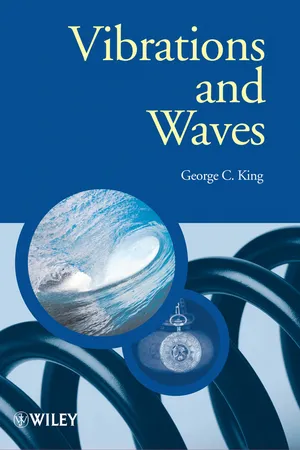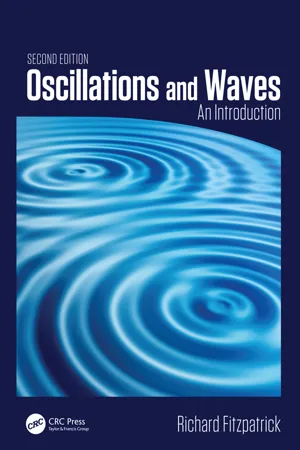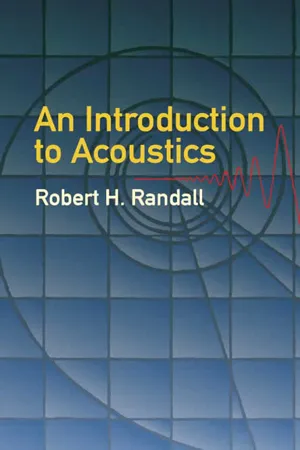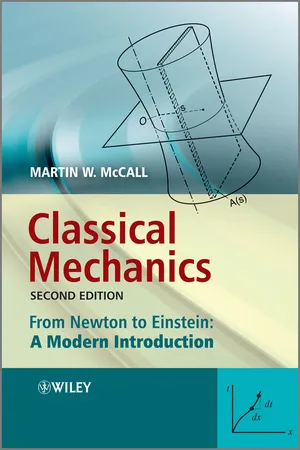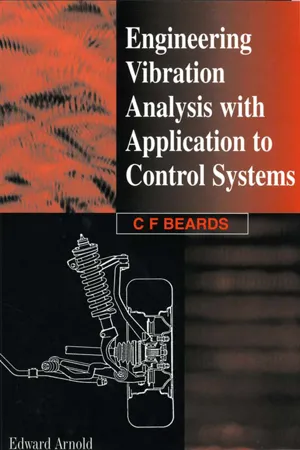Physics
Simple Harmonic Motion
Simple Harmonic Motion refers to the repetitive back-and-forth movement exhibited by certain systems, such as a mass on a spring or a pendulum. It is characterized by a restoring force that is directly proportional to the displacement from the equilibrium position, resulting in a sinusoidal motion. The period and frequency of the motion are determined by the system's mass and the stiffness of the spring.
Written by Perlego with AI-assistance
Related key terms
Related key terms
1 of 4
Related key terms
1 of 3
11 Key excerpts on "Simple Harmonic Motion"
- No longer available |Learn more
- Robert A. Pelcovits, Joshua Farkas(Authors)
- 2023(Publication Date)
- Barrons Educational Services(Publisher)
8Simple Harmonic Motion
Learning Objectives
In this chapter, you will learn:Definition of Simple Harmonic Motion (SHM)Physical systems exhibiting SHMDefinitions of amplitude, frequency, and periodUsing Newton’s laws or conservation of energy in SHM problemsSimple Harmonic Motion (SHM) is any oscillation that is governed by a linear restoring force or restoring torque such that the displacement from equilibrium can be described using sine and/or cosine functions. SHM is a special case of periodic motion, which is any oscillatory repetitive motion due to a restoring force of any form.What Is the General Mathematical Description of a Mass Connected to a Spring Oscillating on a Horizontal Frictionless Surface? We start with Hooke’s law:This is a second-order differential equation. Although you are not responsible for solving it, you should be able to see how the following two equations are solutions to this equation (you can do so by taking their derivatives and inserting them into the above equation).TIP Simple Harmonic Motion: a special kind of oscillatory motionYou should be aware of the following properties of these equations:■Based on the trigonometric identity sin α = cos(α − π/2), these two solutions are equivalent if φ = ϕ − π/2. Therefore, when solving problems, the choice of which equation to use is arbitrary.■There are only two parameters that completely define the spring’s motion: its position and velocity at time t = 0. These two parameters tell us everything there is to know about the system, and from them we can calculate the spring’s velocity and position at any other time. The fact that there are two physical parameters is mirrored by the fact that there are two parameters (A and φ or ϕ) apearing in x(t). This can also be explained mathematically in that two integrations are involved in moving from d2 x/dt2 to x(t - eBook - ePub
Doing Physics with Scientific Notebook
A Problem Solving Approach
- Joseph Gallant(Author)
- 2012(Publication Date)
- Wiley(Publisher)
Chapter 8Harmonic Motion
The study of Harmonic Motion, periodic motion that repeats itself at regular time intervals, is one of the most important and interesting in all of physics. Many physical systems experience such motion, and many cases are exactly solvable. Near a stable equilibrium point, the motion of any system can be approximated as harmonic motion.There are three important properties of Harmonic Motion. The period (T) is the time needed to complete one oscillation. The SI unit is the second, which is the standard metric unit of time. The frequency (f) is the number of oscillations per unit time. The SI unit of frequency is the Hertz (Hz). An oscillating object moves back-and-forth about an equilibrium point. The amplitude (A) is the object’s maximum displacement from equilibrium.It is useful to think of the period as the number of seconds-per-oscillation and the frequency as the number of oscillations-per-second, so that 1 Hz = 1 oscillation / s. As their units suggest, the period and frequency have a reciprocal relationship.(8.1)When you consider oscillations, the period tells you how long, the frequency tells you how often, and the amplitude tells you how far.Simple Harmonic Motion, Simply
Simple Harmonic Motion (SHM) is a special kind of periodic motion where the period and amplitude are constant and the period does not depend on the amplitude. SHM results when the net force acting on an object is proportional to, but in the opposite direction to the displacement from its equilibrium position. This position-dependent force, called Hooke’s Law, always pushes the object toward equilibrium.(8.2)A mass attached to a spring on a frictionless, horizontal surface provides such a linear restoring force. For this system, x is positive or negative when the spring is stretched or compressed. The positive constant k is the property of the spring (called the spring constant) that distinguishes shock absorbers (large k) from Slinkys (small k - eBook - ePub
- George C. King(Author)
- 2013(Publication Date)
- Wiley(Publisher)
1
Simple Harmonic Motion
In the physical world there are many examples of things that vibrate or oscillate, i.e. perform periodic motion. Everyday examples are a swinging pendulum, a plucked guitar string and a car bouncing up and down on its springs. The most basic form of periodic motion is called Simple Harmonic Motion (SHM). In this chapter we develop quantitative descriptions of SHM. We obtain equations for the ways in which the displacement, velocity and acceleration of a simple harmonic oscillator vary with time and the ways in which the kinetic and potential energies of the oscillator vary. To do this we discuss two particularly important examples of SHM: a mass oscillating at the end of a spring and a swinging pendulum. We then extend our discussion to electrical circuits and show that the equations that describe the movement of charge in an oscillating electrical circuit are identical in form to those that describe, for example, the motion of a mass on the end of a spring. Thus if we understand one type of harmonic oscillator then we can readily understand and analyse many other types. The universal importance of SHM is that to a good approximation many real oscillating systems behave like simple harmonic oscillators when they undergo oscillations of small amplitude. Consequently, the elegant mathematical description of the simple harmonic oscillator that we will develop can be applied to a wide range of physical systems.1.1 PHYSICAL CHARACTERISTICS OF SIMPLE HARMONIC OSCILLATORS
Observing the motion of a pendulum can tell us a great deal about the general characteristics of SHM. We could make such a pendulum by suspending an apple from the end of a length of string. When we draw the apple away from its equilibrium position and release it we see that the apple swings back towards the equilibrium position. It starts off from rest but steadily picks up speed. We notice that it overshoots the equilibrium position and does not stop until it reaches the other extreme of its motion. It then swings back toward the equilibrium position and eventually arrives back at its initial position. This pattern then repeats with the apple swinging backwards and forwards periodically . Gravity is the restoring force that attracts the apple back to its equilibrium position. It is the inertia - eBook - ePub
- A. L. Stanford, J. M. Tanner(Authors)
- 2014(Publication Date)
- Academic Press(Publisher)
Idealized systems that execute Simple Harmonic Motion are the primary considerations of this chapter. A discussion of quantities that characterize Simple Harmonic Motion will be followed by a detailed kinematic analysis of that kind of motion. Then we will consider the dynamics of ideal oscillators, relating the forces that cause Simple Harmonic Motion to the motion itself. Energy considerations will complete our analysis of idealized oscillators.Having described idealized Simple Harmonic Motion in terms of kinematics, dynamics, and energetics, we will turn our attention to more realistic mechanical oscillators. Damped oscillations, back and forth motions with decreasing energies, will be given a brief treatment. Finally, oscillators that are driven, or forced, by an external mechanism will be discussed qualitatively. These forced oscillations demonstrate resonance, an important physical phenomenon observed in many kinds of systems.8.1 Simple Harmonic Motion
Our description of Simple Harmonic Motion will necessarily be essentially mathematical. You may wish to create a mental image of the kind of motion we are describing by imagining a long spring hanging from a ceiling with a block attached to the lower end of the spring. When the block has been pulled downward and released, it oscillates, vertically in this case. First we will describe an idealization, that is, a frictionless version, of this kind of motion.Let us consider the rectilinear (straight-line) motion of a particle with displacement from x = 0 that is described byx(8-1)( t )= A cos(ω t + ϕ)(8-1)where A , ω, and ϕ are constants. Motion of this type is said to be “harmonic” because it can be described by sinusoidal (sine or cosine) functions. The motion is said to be “simple” in that only one sine or cosine function is required to describe it. Equation (8-1) , therefore, describes the displacement from x = 0 of a particle executing Simple Harmonic Motion . The argument (ωt + ϕ) of the cosine factor in Equation (8-1) is called the phase of the oscillation, and ϕ is called the phase constant . Since A is a constant, the displacement x of the particle is periodic because cosine is a periodic function that repeats itself each time the phase increases by 2π radians. Furthermore, x ranges from x = A , when the cosine factor is equal to 1, to x = −A , when the cosine factor is equal to −1, and back again to x = A , and so on, as time proceeds from t - eBook - ePub
Oscillations and Waves
An Introduction, Second Edition
- Richard Fitzpatrick(Author)
- 2018(Publication Date)
- CRC Press(Publisher)
CHAPTER 1Simple Harmonic Oscillation
1.1 INTRODUCTIONThe aim of this chapter is to investigate a particularly straightforward type of motion known as simple harmonic oscillation, and also to introduce the differential equation that governs such motion, which is known as the simple harmonic oscillator equation. We shall discover that simple harmonic oscillation always involves a back and forth flow of energy between two different energy types, with the total energy remaining constant in time. We shall also learn that the linear nature of the simple harmonic oscillator equation greatly facilitates its solution. In this chapter, examples are drawn from simple mechanical and electrical systems.1.2 MASS ON SPRINGConsider a compact mass m that slides over a frictionless horizontal surface. Suppose that the mass is attached to one end of a light horizontal spring whose other end is anchored in an immovable wall. See Figure 1.1 . At time t, let x(t) be the extension of the spring; that is, the difference between the spring’s actual length and its unstretched length. x(t) can also be used as a coordinate to determine the instantaneous horizontal displacement of the mass.The equilibrium state of the system corresponds to the situation in which the mass is at rest, and the spring is unextended (i.e., x = ẋ = 0, where ̇. ≡ d/dt). In this state, zero horizontal force acts on the mass, and so there is no reason for it to start to move. However, if the system is perturbed from its equilibrium state (i.e., if the mass is displaced horizontally, such that the spring becomes extended) then the mass experiences a horizontal force given by Hooke’s law,f(1.1)( x )= − k x .FIGURE 1.1 Mass on a spring.Here, k > 0 is the so-called force constant of the spring. The negative sign in the preceding expression indicates that f(x) is a so-called restoring force that always acts to return the displacement, x, to its equilibrium value, x = 0 (i.e., if the displacement is positive then the force is negative, and vice versa). Note that the magnitude of the restoring force is directly proportional to the displacement of the mass from its equilibrium position (i.e., | f | ∝ x). Hooke’s law only holds for relatively small spring extensions. Hence, the mass’s displacement cannot be made too large, otherwise Equation (1.1) ceases to be valid. Incidentally, the motion of this particular dynamical system is representative of the motion of a wide variety of different mechanical systems when they are slightly disturbed from a stable equilibrium state. (See Sections 1.5 - eBook - ePub
- H. John Pain(Author)
- 2013(Publication Date)
- Wiley(Publisher)
1
Simple Harmonic Motion
At first sight the eight physical systems in Figure 1.1 appear to have little in common.1.1(a) is a simple pendulum, a mass m swinging at the end of a light rigid rod of length l . 1.1(b) is a flat disc supported by a rigid wire through its centre and oscillating through small angles in the plane of its circumference. 1.1(c) is a mass fixed to a wall via a spring of stiffness s sliding to and fro in the x direction on a frictionless plane. 1.1(d) is a mass m at the centre of a light string of length 2l fixed at both ends under a constant tension T . The mass vibrates in the plane of the paper. 1.1(e) is a frictionless U-tube of constant cross-sectional area containing a length l of liquid, density ρ , oscillating about its equilibrium position of equal levels in each limb. 1.1(f) is an open flask of volume V and a neck of length l and constant cross-sectional area A in which the air of density ρ vibrates as sound passes across the neck. 1.1(g) is a hydrometer, a body of mass m floating in a liquid of density ρ with a neck of constant cross-sectional area cutting the liquid surface. When depressed slightly from its equilibrium position it performs small vertical oscillations. 1.1(h) is an electrical circuit, an inductance L connected across a capacitance C carrying a charge q . All of these systems are simple harmonic oscillators which, when slightly disturbed from their equilibrium or rest postion, will oscillate with Simple Harmonic Motion. This is the most fundamental vibration of a single particle or one-dimensional system. A small displacement x from its equilibrium position sets up a restoring force which is proportional to x acting in a direction towards the equilibrium position.Thus, this restoring force F may be writtenwhere s , the constant of proportionality, is called the stiffness and the negative sign shows that the force is acting against the direction of increasing displacement and back towards the equilibrium position. A constant value of the stiffness restricts the displacement x - eBook - ePub
- Robert H. Randall(Author)
- 2012(Publication Date)
- Dover Publications(Publisher)
CHAPTER 1FUNDAMENTAL PARTICLE VIBRATION THEORY
The production of sound always involves some vibrating source. Such a source is often of irregular shape, and rarely do all parts of the vibrating surface move as a unit. It is the very complexity of the vibration of a sound source that makes it necessary to consider first the simplest vibrating body, the particle . The motion of actual sources may approximate that of a particle, particularly at low frequencies. Whenever this approximation may not be made, the vibrating surface may be broken up into smaller areas, infinitesimal if desired, the sum effect of which is equivalent to that of the total surface area of the actual source. The mathematics of this summation may be extremely complicated, but approximations will often lead to useful results.1-1 Simple Harmonic Motion of a particle.
Simple Harmonic Motion originates, in mechanics, because of the existence of some kind of unbalanced elastic force. With such a force, Newton’s second law becomes, for a particle of mass m, free to move along the x -axis,(1–1)In the expression on the right for the force, K is called the elastic constant, and the negative sign indicates that the restoring force always acts towards the origin. Equation (1-1) may also be written(1–2)where ω 2 = K/m. This differential equation completely defines the type of motion and from it all other properties of Simple Harmonic Motion may be obtained. By integrating Eq. (1-2) twice, the displacement equation may be shown to be of the form(1–3)where x m . is the amplitude of the motion and α is called the phase angle. The quantities x m and α are essentially constants of integration, whose values depend upon the mathematical boundary conditions. They may easily be determined, for instance, if one knows the value of x and of the velocity, , at either the time t = 0, or at any other specific value of the time. Whether the cosine or the sine function appears in Eq. (1-3) is dependent upon these boundary conditions. If, for instance, α turns out to be ±π/ 2, Eq. (1-3) may be written in the sine form. The angular frequency, ω , is equal to 2πƒ, where f - eBook - ePub
Classical Mechanics
From Newton to Einstein: A Modern Introduction
- Martin W. McCall(Author)
- 2011(Publication Date)
- Wiley(Publisher)
frequency .How are the arbitrary constants corresponding to the oscillation amplitude, A , and phase constant, ϕ , to be determined? Normally we are told two facts about the state of the body at time t = 0, namely the body’s initial position and initial velocity, which together fix A and ϕ . These facts are generally referred to as initial conditions.Let us apply these ideas with a simple example. A 2 kg mass is attached to horizontal spring and displaced 1 mm from equilibrium by a force of 5 N, and then released from rest. What is the subsequent motion?If the static extension is x 0 , then F = −kx 0 ⇒ k = 5/0.001 = 5000N m−1 . Also, ω 0 2 = k/m = 5000/2 ⇒ ω 0 = 50 rad s-1 . Now applying the initial conditions to the general solution x = A cos(ω 0 t + ϕ ):x = x 0 at t = 0 ⇒ x 0 = A cos ϕ ,= 0 at t = 0 ⇒ 0 = −ω 0 A sin(ϕ ).Between these equations we deduce that ϕ = 0 and A = x 0 so(3.7)3.5 Energy in Simple Harmonic MotionWe now examine SHM further using energy concepts. Since the restoring force is conservative, we can define a potential energy, and further, that the total mechanical energy, kinetic plus potential, is a conserved quantity. We have proved these ideas in general previously. Let us see how it all checks out for SHM.The conservative restoring force in SHM is F = −kx , which can be derived from a potential function according to −kx = −dU/dx . Hence(3.8)The total mechanical energy is therefore(3.9)The time-independence of E can be checked by substituting the general solution x (t ) from Equation (3.6 ):But ω 0 2 = k/m , so(3.10)Figure 3.3Time dependence of the kinetic and potential energy in SHM when ϕ = 0.which is constant as claimed. The kinetic energy and the potential energy are time-dependent as shown in Figure 3.3 (for ϕ = 0), but their sum representing the total energy is constant. The potential energy and the kinetic energy are exchanged four times every oscillation period, whilst the total mechanical energy (= mω 0 2 A 2 / 2) corresponds to the potential energy at maximum displacement x = A , or the kinetic energy at the equilibrium position x - C. Beards(Author)
- 1995(Publication Date)
- Butterworth-Heinemann(Publisher)
0 , which is found from the initial conditions. The mass of the body is important, its weight is not, so that for a given system, ω is independent of the local gravitational field.The frequency of vibration, f , is given by(2.4)The motion is as shown in Fig. 2.3 .The period of the oscillation, τ, is the time taken for one complete cycle so thatFig. 2.3 Simple Harmonic Motion.(2.5)The analysis of the vibration of a body supported to vibrate only in the vertical or y direction can be carried out in a similar way to that above. Fig. 2.4 shows the system.Fig. 2.4 Vertical motion.The spring extension δ when the body is fastened to the spring is given by k δ = mg . When the body is given an additional displacement y 0 and released the FBDs for a general displacement y , are as in Fig. 2.5 .The equation of motion is that is,Fig. 2.5 (a) Applied forces; (b) effective force.(2.6)This is similar to equation (2.1) , so that the general solution can be written as(2.7)Note that , because mg = kδ . That is, if δ is known, then the frequency of vibration can be found.For the initial conditions y = y 0 at t = 0 and at t = 0,(2.8)Comparing (2.8) with (2.3) shows that for a given system the frequency of vibration is the same whether the body vibrates in a horizontal or vertical direction.Sometimes more than one spring acts in a vibrating system. The spring, which is considered to be an elastic element of constant stiffness, can take many forms in practice; for example, it may be a wire coil, rubber block, beam or air bag. Combined spring units can be replaced in the analysis by a single spring of equivalent stiffness as follows.(1) Springs connected in seriesThe three-spring system of Fig. 2.6(a) . can be replaced by the equivalent spring of Fig. 2.6(b) .Fig. 2.6- eBook - ePub
- Zhi-Fang Fu, Jimin He(Authors)
- 2001(Publication Date)
- Butterworth-Heinemann(Publisher)
Harmonic vibration of an SDoF system is the most fundamental type of vibration and is the building blocks for more sophisticated types of vibration. From Fourier series we know that a periodic vibration consists of a finite number of simple harmonic vibrations whose frequencies are multiples of a fundamental frequency. From Fourier transform we appreciate that a non-periodic vibration, which can be viewed as a periodic vibration whose period is infinity, consists of an infinite number of harmonic vibrations covering every frequency within a range.Before discussing the harmonic vibration of an SDoF system, it is useful to refresh the features of a simple harmonic signal. A time domain harmonic signal x (t ) with period T and circular frequency can be seen as the projection along the time axis of a vector of length X rotating counterclockwise, as shown in Figure 3.4 .This time domain signal can be conveniently expressed as:Figure 3.4 A harmonic signal generated by a rotating vector(3.5)If x (t ) represents a displacement vibration signal, then the velocity and acceleration can be determined from its first and second order derivatives with respect to time.Owing to the simplicity of the sinusoidal function, both the amplitudes and the relative phases of the velocity and acceleration can be determined from those of the displacement. The amplitudes and relative phases between the displacement, velocity and acceleration can be written as:(3.6a)(3.6b)(3.7a)and(3.7b)Using complex variables, equations (3.6) and (3.7) can be combined. As a result, the displacement, velocity and acceleration can be related conveniently as follows:(3.8a)and(3.8b)Here, ‘j ’ is the imaginary unit.Pure harmonic vibration of an SDoF system occurs in two possible occasions. The first is the free vibration of an SDoF system without damping (therefore no energy dissipation). This has been solved. The second is the vibration when the system is subjected to an external harmonic force. Assume now the system also has a viscous damper with damping value c . This value is equal to the damping force quantity for a unit velocity. The system is subjected to an external harmonic force characterized as F 0 sin ωt , as shown in Figure 3.5 - eBook - ePub
- Sir James H. Jeans(Author)
- 2013(Publication Date)
- Dover Publications(Publisher)
a , provided this does not involve the string ever becoming unstretched. Find the period of the motion.THE CYCLOIDAL PENDULUM
210 . We have seen that the motion of a simple pendulum is Simple Harmonic Motion only so long as the amplitude of the motion is small. It is, however, possible to constrain a particle to move under gravity in such a way that its motion shall be Simple Harmonic Motion no matter how great the amplitude.To find the curve in which the particle must be constrained to move, let us go back to equation (94), namelywhich is the equation of motion of a particle constrained to move in any curve, provided θ is the angle which the tangent to the curve at a distance s along it makes with the horizontal. For this equation to represent Simple Harmonic Motion, the acceleration must be equal to — k 2 s. Thus we must have(99)so that sin θ must be proportional to s.211. This relation expresses a property of the cycloid, — i.e. of the curve described in space by a point on the rim of a circle which rolls along a straight line. For, in fig. 132 , let P be a point on a cycloid which is formed by a circle rolling along the line EF. When the point on the rim of the moving circle is at P, let A be the point of the circle which is in contact with the line EF; and let AB be the diameter of the circle which passes through A.FIG. 132At the instant considered, we know that the motion of the point P on the rim of the circle is perpendicular to the line AP (see example 1 on p. 9). Thus since APB is a right angle, the motion must be along BP. Thus BP
Index pages curate the most relevant extracts from our library of academic textbooks. They’ve been created using an in-house natural language model (NLM), each adding context and meaning to key research topics.
Explore more topic indexes
Explore more topic indexes
1 of 6
Explore more topic indexes
1 of 4


